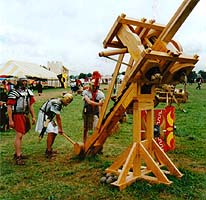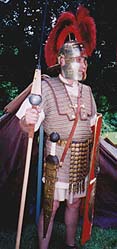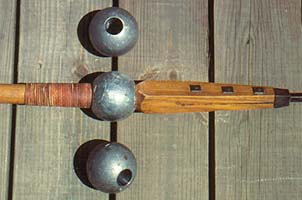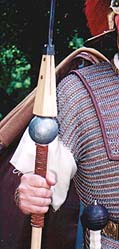
WEAPONS AND CATAPULTS
REVISED JUNE 22, 2005
Click Picture for Enlargement, Narrative and Details of this accurate Ballista Replica and Photos of the Commander's 1/20 scale Trebuchet in Action and details
"GLADIUS" SHORT SWORD
An array of gladius swords of various styles and makers. Left to Right are: Scabbard and Mainz pattern gladius and to their right, another Mainz gladius and scabbard, all custom made by Lonely Mountain Forge Armory * Museum Replicas Pompeii pattern gladius and Mainz scabbard, both by Windless Steelcrafts of India * Pompeii gladius by Angus Trim from Albion Armorers * Scabbard and Pompeii gladius by Deepeeka of India * Wood practice "waster" gladius similar to the "Rudus" or wooden sword presented by the Emperor to retiring gladiators. Click picture for enlarged views.

The classic Roman short sword "Gladius Hispaniensis" (Spanish Sword), is one of the most famous of all weapons. It is a short stabbing weapon, meant to be used in the close fighting quarters in which the Roman Army excelled. It is thought to have been adopted from Spanish Auxiliaries serving with Hannibal’s forces in the Second Century BC.
Earlier types, such as the "Mainz" version, had a wider, wasp-waisted blade with a longer point. The later "Pompeii" version, had a somewhat narrower, and easier to manufacture, straight sided blade, which came into use during the 1st Century AD.
The Gladius was most always carried at the right side of the body, suspended from a narrow baldric belt, as the "Scutum" or shield carried on the left, made it impractical to be drawn across the body from the left side. The term "Gladiator" comes from the use of the Gladius by these fighters in the arena. The Gladius remained the principle side-arm weapon of the Roman soldier well into the Third Century AD, when longer "Spatha" type swords, worn at the left side of the body, along with smaller shields were adopted.
"PILUM" or JAVELIN

An array of pilum javelins showing details of the butt spike and head attachment. The top pilum displays the three peened rivets and square cut washers of brass that secure the shank into the head of the pilum shaft. The bottom view shows the slot cut into the trapezoidal head of the wood shaft to accept the flattened tang of the soft iron pilum. Note the iron ferrule that clenches and protects the slot from splitting and damage. The wood shaft and head are hewn from one piece of wood, generally ash. The center shaft displays the iron butt spike. Note the small trapezoidal point and tapering shaft of the iron pilum head.
The javelin or pilum, sometimes termed as "Rome's Secret Weapon", consists of a long iron head with a small point, mounted on a wooden shaft. On the most common type, the bottom of the head widens into a flat tang, which is riveted into the widened top of the wood shaft. The second type had a socketed head, and a third type, less well-known, used a spike tang. In the First Century AD, some tanged pila are shown with a spherical weight, presumed to be lead, behind the joint block. Here a five pound commercial fishing net sinker was drilled to accommodate the shaft, resulting in a final weight of three pounds. Historically, the weight is thought to have been cast in place around the shaft. Apparently the weapon had become lighter over the centuries, and the weight was added to increase its "punch".



Heavy Pilum shown with a lead weight behind the joint block to increase range and
impact force. The right and left views shows the Commander with a pilum assembled by
Jeff Crean of Legion XX. The center view illustrates a lead weight mounted one of
the Commander's pilums and two of the drilled weights.
A number of these three pound finished weights are available, drilled to fit your 1-1/8 inch+ shaft, $30 postpaid. Send CK/MO payable to George Metz - 13 Post Run - Newtown Square, PA 19073-3014 610-353-4982 Hole diameters range from 1.145 to 1.170 inches (1-1/8 inches = 1.125 * 1-1/4 inches = 1.250) Send an accurate shaft diameter measurement or call - e-mail to discuss size needed.

Before the Roman infantryman charged with his short stabbing sword, he threw one or both of the "Pila" he normally carried. The effective range was about 20+ yards, depending on its weight and the strength of the thrower. The most famous feature of this weapon was its ability to bend, if only slightly, on impact, making it impractical to be thrown back effectively by an enemy soldier. However its prime function was to kill or at least pierce an enemy’s shield and possibly his armour and body as well. Regardless, the soft iron shaft was intended to bend after penetrating the adversaries shield, thus encumbering him while the Roman soldier drew his sword and advanced to engage his enemy. After the battle was over, the Pilum could be retrieved and straightened to be used again. The Pilum was based on similar Greek weapons and was in use throughout the times of the Roman Conquest. During the Republic, each legionary generally carried two pila, one "light" and one "heavy". In Imperial Times, two pila were apparently still carried, with both being of the "heavier" style.
CATAPULTA - BALLISTA - SCORPIO - CHEIROBALLISTRA

Interpretation of large Roman field Ballista from "Weapons" Edwin Tunis, 1954
Go to our Catapulta Page for photos and details on torsion powered catapults and Legion XXIV's two "Engines of Terror" Catapult and Onager. See a large Greek Palitones Ballista on our Ballista Page.
ONAGER - MANGONEL
"Onager" or "Onagrus" was the term applied to a siege engine developed by the Romans during the 3rd Century AD. It utilized a single vertical arm and sling powered by a large horizontal "skein" of rope and sinew coiled and twisted to create a rotational force. The Onager is the style of siege engine most people today associate with the term "Catapult", from the Greek katapeltes, "shield piecer" (kata = through pelta = small shield"). The name "Onager or Onagrus", Latin for donkey or "wildass", came from the jumping or wild kicking motion of the machine when it would rear-up its back end as it was discharged. It was an easier to construct and maintain alternative to the "Ballista" or "Palintones" catapult, which was the largest of the siege weapons normally used by the Romans. The Ballista was complicated to build and due to its size, was difficult to transport. Maintaining a Ballista in good working order was also an ongoing endeavor.
The Onager, on the other hand, was basically one half of a Ballista, turned 90 degrees, having only one instead of the two twisted rope skeins, as employed by the Ballista, to provide the power for casting objects toward an enemy. It had a rectangular frame, composed of large timbers resting on the ground; through the center sides of which were drilled two holes to anchor the one large horizontal sinew rope skein or spring made up of twisted leather thongs, gut or hemp. In the middle of the skein was placed a large casting arm, fitted with a spoon or sling for holding the object to be thrown. The method of how the Romans were able to make such effective ballista and onager springs has been lost. There appears to be no evidence that the Romans ever employed metal springs to power their siege engines.
Both the Ballista and Onager were rather high-maintenance devices and were vulnerable to having their leather or sinew or hemp skeins get wet or even damp, which would cause them to slacken and lose tension, rendering the engine useless. Also, both types of machines required a skilled crew to tighten the skeins and keep the weapon adjusted and ready for deployment. This was difficult enough in peaceful conditions, not to mention during the heat of battle, so the death or injury of a critical crew member could compromise the effectiveness of the weapon.
The arm was cranked down with a windlass operated by up to four soldiers further torsioning the skein to provide the required throwing power; the arm being held in position by a ratchet and pawl. Upon release, the arm would snap forward to a sudden stop against a braced upright at the forward end of the machine, while the object being cast continued on toward the intended target. While simpler to construct, the onager provided the same amount of throwing power as the more complicated ballista, but was more difficult to keep aligned on a target, due to the "wildass" kicking motion of the weapon, when the casting arm was halted by the stop frame. The term "Onager" also referred to the action of a pig kicking stones behind it as it ran when pursued. A large onager was just as difficult to transport as a large ballista and was generally used as a stationary siege engine.
With the Fall of the Western Roman Empire and the onset of the Dark Ages, the Onager fell into disuse. During the early Middle Ages, the Onager came back into use when the military tacticians of the day looked back to the ancients for inspiration. However, the sling at the end of the arm was replaced by an inferior metal or wooden scoop and the medieval onager or "Mangonel" as it was then termed, remained a poor relation to the Roman Onager. The Mangonel, from the Latin "Manganon" or "engine of war" was often referred to as a "Gonne", from which our modern term "Gun" is derived.
888888888888888888888888888888888888888888888888888888888888888888888888888
OTHER CATAPULTS NOT USED BY THE ROMAN MILITARY
"TRACTION" TREBUCHET
The term "Traction Trebuchet" is generally applied to human powered beam-sling type stone throwing siege weapons. The Romans used the "Beam & Sling" concept on many of their torsion-powered Onager catapults; but it was the Chinese, in the 3rd to 5th Centuries BC, who devised the idea of mounting a large beam and sling on a wooden frame and utilizing human energy to power it. Traction Trebuchet type weapons reached the middle-east by the 7th Century AD. The smallest of these machines could be powered by the weight and pulling strength of one person using a single rope; but most required the use of from 20 to 100 men and/or women, generally two per rope, using their combined weight and pulling strength to power the weapon. These teams would frequently be local non-combatants (women, children, older men) assisting in the siege or in the defense of their town. Traction Trebs had a range of from 200 to well over 300 feet (60 to 100+ meters) casting weights up to 130 pounds (60kg). Consult www.legionxxiv.org/trebuchetpage for an illustration and more details on Traction type Trebuchets.
TREBUCHET
The Trebuchet was a weight or gravity powered catapult, as opposed to the torsion powered catapults and ballista used by the Romans. It was quite literally, the heavy artillery of the Middle Ages. The Trebuchet was not known or used by the Roman Military. It was developed in China and did not reach Western Europe until about 1300 AD. The Romans however, did utilize the Trebuchet's "Beam & Sling" concept with many of their Onager type catapult weapons. Consult www.legionxxiv.org/trebuchetpage for details on this siege engine of the Middle Ages and the Commander's 1/20 scale working reproduction.
** SITE INDEX **
* HOME * TOP * EQUIPMENT * STANDARDS * GLOSSARY *
* GREEK BALLISTA PAGE * LEGION XXIV CATAPULTA * TREBUCHET PAGE *
Visits to the Weapons Page of Legion XXIV since January 28, 2000